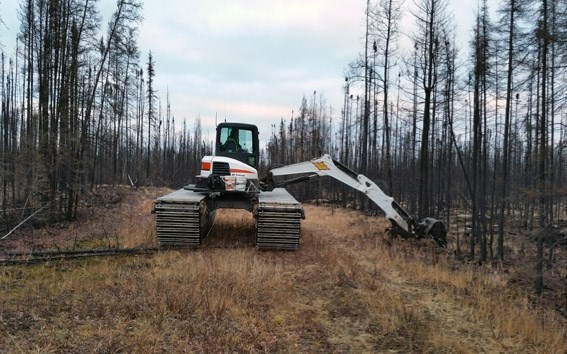Cenovus has reinvented oil sands restoration, thanks to new “game-changing” equipment.
Using amphibious vehicles, the oil giant is able to continue restoration on seismic lines year-round, including those on the Cold Lake Air Weapons Range (CLAWR). The unique vehicle allows them to restore two times more land per day, while reducing costs.
“They look very much like traditional excavators. The primary difference is that the tracks on them surround large air-filled drums. So those drums allow the equipment to work very safely with minimal footprints on some of the muskegs, peat sand, and other soft land we have within the oil sands region,” explained Ted Johnson, Cenovus group lead of environmental solutions and systems.
The amphibious vehicles are a continuation of Cenovus' 10-year commitment to restore woodland caribou habitat. The company announced earlier this year they would be putting $32 million into treating 3,900-square kilometres of land near Foster Creek, in an effort to reinvigorate the declining herd.
To aid in their efforts, they brought in the amphibious vehicles. Starting with a small-scale trial in November 2015 to test two of the vehicles on the CLAWR, Johnson said the results were “quite encouraging.”
“The equipment treats the ground at twice the rate that they were able to do in the winter, partly because our treatments are easier when the ground isn't frozen. The costs are lower than they were in the winter, and our treatment season has expanded about three times.”
The pilot showed initial cost-saving estimates of 25 to 50 per cent, compared to the winter restoration program. With less pressure per square inch than a human foot, trials also confirmed that restoration could potentially be carried out for up to 120 days during the summer, on top of the already 60 days of work in January and February.
Since the trial, over the past year, Cenovus has deployed the amphibious vehicles on a larger-scale.
“We used amphibious equipment to do about 25 per cent of our total restoration work, about 50-kilometres of historic seismic line; that was one of the next steps to test the functionality,” said Johnson.
The first amphibious track-hoe was five tonnes and brought in from Louisiana, as one that size didn't exist in the province. The second, a 20-tonne excavator, came up from southern Alberta. For their larger deployment, Cenovus had a contractor custom build a brand new piece of equipment with an amphibious track system.
Finding success so far, the next step will be testing out different restoration techniques. One idea is attaching a tree spade, a cone-shaped tool used to live-transplant trees, onto the end of an amphibious track-hoe.
“We've had one of the track-hoes modified to hold the tree spade so it can take trees and their understory community. That way it can take trees adjacent to the seismic line and transplant them right onto the seismic line,” Johnson explained, adding that they're also looking into other unique soil treatments that can be done under frost-free conditions.
Cenovus developed this innovative approach to restoration in partnership with Canada's Oil Sands Innovation Alliance (COSIA), ConocoPhillips, and Devon Energy. Recently, Nexen also joined the project. Results from the pilots have been shared with not only the partner corporations, but also the 13 oil sands companies who are members of COSIA.
Cenovus will be continuing to use amphibious vehicles for their ongoing caribou habitat restoration work in 2017.



